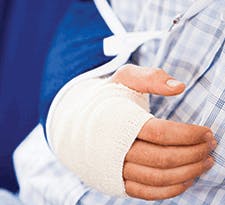Elective Surgeries, Hidden Responsibilities and Safety Program Management
An unforeseen risk factor for injury was brought to light recently in Ohio, where two employees in a span of two weeks fell while at work and broke a bone. One employee, a nurse, was hospitalized and required surgery to repair her fractured hip.
Immersed in the process of seeking to reduce hazards in the workplace, a staff development coordinator, who also was the safety specialist, reported what seemed to an unrelated commonality: Both injured employees had undergone gastric bypass procedures. Could the surgery and its aftereffects link these two OSHA recordable injuries?
As safety professionals, we try to recognize (even predict) hazards so employers can apply the recommended protection measure or redesign the workplace to eliminate incidents. Often, we find ourselves reviewing accident reports and evaluating contributing factors, focusing on the behavioral aspects and physical conditions observed and reported right before the incident occurred. Similar incidents may share common elements; we seek to understand these trends in order to mitigate their reoccurrence.
The Link to Bariatric Surgery
Bariatric surgery is an operation on the stomach or intestines that helps patients with extreme obesity to lose weight. This surgery is an option for people who cannot lose weight by other means or who suffer from serious health problems related to obesity. Between 2011 and 2013, the number of bariatric surgeries performed in the United States grew by nearly 15 percent, according to new estimates from the American Society for Metabolic and Bariatric Surgery (ASMBS).
According to recent studies performed by researchers at the Division of Endocrinology of the Columbia University College of Physicians and Surgeons' Department of Medicine, bariatric patients had an increased incidence of all fracture, fractures due to minimal or moderate trauma and fractures of the hip, spine, wrist and humerus. Risk was greatest for appendicular fractures; half of all fractures occurred in the foot, leg or hand.
According to researchers, Vitamin D deficiency and lower preoperative activity were predictors of fracture. The researchers noted that one of the side effects of these procedures was a detrimental effect on bone and mineral metabolism. They also noted a trend toward increased fracture risk in bariatric patients after 3-5 years and in those with the greatest decline in BMI.
While it was explained in the study that,"Bariatric surgery is an effective and increasingly common treatment for severe obesity and its many co-morbidities," nurses and nursing aides fall within a population that may elect (and can afford) a bariatric surgery such as gastric bypass as a viable option in reducing weight and ensuring healthier years ahead.
Already at Risk for Falls
While slip, trip and fall hazards can occur in any work environment, they are prevalent in healthcare settings. Historically, the injury rate for workers in these facilities is double the injury rate for all full-time workers in other occupations.
In an effort to reduce the high injury rates in the healthcare industry, OSHA has reissued its National Emphasis Program to use both enforcement and collaborative efforts to address hazards such as musculoskeletal disorders from lifting patients or residents, exposures to tuberculosis and bloodborne pathogens, workplace violence and slips, trips and falls.
Today, nursing homes and residential care facilities employ approximately 2.8 million workers at 21,000 work sites. Many nursing home tasks require considerable lifting and other strenuous physical labor. OSHA has focused attention on the industry, due in part to the consistently high number of recordable injuries suffered by nurses and nurses' aides when assisting residents in and out of beds, showers and wheelchairs.
When there is a mismatch between the physical requirements of the job and the physical capacity of the worker, work-related musculoskeletal disorders (MSDs) can result. OSHA has recommended a zero-lift policy for all continuing care facilities.
Avoiding Slips and Falls
OSHA specifically focuses on making sure aisles and work floors remain clear and dry to enable stability of the worker. Training and routine inspection by first-line supervisors should catch many slip and trip hazards. But is a fall the only way a bone could break? Or could physical exertion (like lifting a box of files, carrying a crate or providing an assisted lift of a resident) add enough pressure to a calcium-deprived bone to cause it to fracture simply from the added weight or pressure?
A fragility fracture (a fracture from a minor injury) often is an indicator of problem with bone density. When the unintended consequences of an elective surgery like bariatric bypass and its associated bone loss could have contributed to an employee's injury and in turn impact the employer injury rates, what reasonable action should or could the employer take?
What Can the Employer Do?
Legally, it is the employer's responsibility to keep a workplace free from recognized hazards, but recognizing hazards takes a lot of effort and an understanding of safe work practice. Employers now may need to include employees' elective surgeries as part of the equation when determining risk factors.
How can an employer monitor when there's an occupational risk that injury can occur in apart as a result of elective surgery? Unless the employee voluntarily reports the surgery, there's nothing an employer can do. Many employers are not even aware when employees take medications that have side effects warning them not to operate heavy equipment or machinery, so asking employees to self-report elective surgery might be asking a lot.
But do employees have an obligation to the people around them who may be impacted by their actions? Taking personal responsibility for safety or having your employer monitor your treatments and medical procedures may require a team approach.
OSHA collects injury records in part to allow other related agencies to develop and study trend analysis. The goal is to create general awareness about these conditions and tailor the priorities of consultation programs to fit, while guiding enforcement programs to tackle employers who may not be paying enough attention. Although if prevailing injuries are not related to the exposure at the workplace, but rather to an elective surgery that really bears no direct relationship to the employer, would counting these cases of broken bones as recordable injuries actually benefit the national trend analysis or simply skew the results?
Determination of Work-Relatedness
In order to be recorded, an injury must be work-related. The litmus test to prove an injury is work-related includes:
- Cases caused by events or exposures in the work environment.
- Cases contributed to by events or exposures in the work environment.
- Cases significantly aggravated by events or exposures in the work environment.
Section 1904.5(b)(2) asks the employer, "Are there situations where an injury or illness occurs in the work environment and is not considered work-related?"
An injury or illness occurring in the work environment that falls under one of the following exceptions is not work-related, and therefore is not recordable:
- You are not required to record injuries and illnesses if the injury or illness involves signs or symptoms that surface at work but result solely from a non-work-related event or exposure that occurs outside the work environment.(1904.5(b)(2)(ii)
- You are not required to record injuries and illnesses if the injury or illness results solely from voluntary participation in a wellness program or in a medical, fitness or recreational activity such as blood donation, physical examination, flu shot, exercise class, racquetball or baseball. (1904.5(b)(2)(iii).
Extrapolating from these two injuries, can we confirm a broken bone was a result of a non-work-related injury or illness that occurred outside the work environment? Or, did the broken bone result from voluntary participation in a medical activity?
Remember, the result of this elective surgery has been clinically proven to lead to malabsorption of calcium and the weakening of bones over time. Could it result in the bones fracturing? The employer must evaluate the employee's work duties and the work environment to decide whether an event or exposure in the work environment either caused or contributed to the injury or significantly aggravated a pre-existing condition. If so, the case is work-related.
When Numbers Matter
The OSHA On-Site Consultation Program administers OSHA's Safety and Health Achievement Recognition Program (SHARP), a national program that recognizes small business employers who operate an exemplary injury and illness prevention program. Acceptance into SHARP is an achievement of status that singles out employers from among their business peers as a model for worksite safety and health. Upon receiving SHARP recognition, OSHA exempts that worksite from programmed inspections during the period that the SHARP certification is valid. In Ohio, the OSHA On-Site Consultation Program is administered through the Ohio Bureau of Worker's Compensation.
The continuing care facility mentioned at the start of this article is one of two dozen or so companies currently active in OSHA's SHARP program in Ohio. Along with maintaining an effective safety and health management program, the employer injury and illness rates like days away, restricted or transferred (DART) and total recordable case rate (TRC) have to be maintained below industry average to remain in the SHARP program.
The facts of this case currently are inconclusive, but two employees suffered injuries and now the employer must decide if both meet the definition of a recordable injury. What do you think?
Keith Bullock, CSP, has been a safety consultant for the OSHA On-Site Consultation Program of the Ohio Bureau of Workers' Compensation since 2001. Before that, he worked for the state of Ohio, enforcing OSHA regulations in the public sector as part of the Public Employment Risk Reduction Program. He received his Master of Arts and Liberal Studies in occupational health and safety/environmental studies from the State University at Stony Brook, N.Y., and his bachelor of science in environmental studies from the New York College of Environmental Science and Forestry. Syracuse, N.Y. He can be reached at [email protected].

